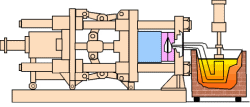Advantages of Die Casting Zinc Alloys. Die casting is a process that has quickly earned worldwide preference in the industrial community over the last few decades. The process has proved itself to be more efficient, economical, and quality-oriented as opposed to other casting processes out there. This is why there are now more die cast parts being sold than any other cast parts. One of the most important things to consider in the die casting process is the material to be used. In this aspect, zinc alloys are certainly some of the most popular choices. Die casting zinc alloys provide manufacturers and their customers alike with various advantages, which this article will briefly point out.
First of all, die casting zinc alloys are not as expensive as other alloys available. In fact, they are the cheapest materials as far as production (and post-production) costs in the die casting process are concerned. This is because they zinc alloys have excellent finishing properties that make them ready for selling even without undergoing polishing from tooling machines. Part consolidation eliminates further operations. Zinc is also the easiest alloy to cast. Zinc alloys all have high impact strength and ductility. They give consistent quality even when created in large volumes, resulting in the long life of the die molds used and the cost-effectiveness of all production stages. Die casting zinc alloys also require only minimal draft angles on their internal features so that their collective unit price is lower, bringing much financial convenience to both the manufacturers and the consumers.
Die Casting Blog gives information on how to get a zinc die casting part for manufacturers. If you are looking for Die Casting Zinc Alloys or if you need ZA Die Casting Alloys will give you more information you can use for manufacturing.


